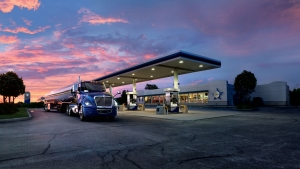New International LT Series boosts fuel economy 7%
 LAS VEGAS, NV – International’s new flagship line of Class 8 over-the-road trucks – the LT Series — has been unveiled with a wide array of driver-friendly improvements in the cab, and the promise of “unrivaled fuel efficiency” overall.
LAS VEGAS, NV – International’s new flagship line of Class 8 over-the-road trucks – the LT Series — has been unveiled with a wide array of driver-friendly improvements in the cab, and the promise of “unrivaled fuel efficiency” overall.
“The new International LT Series reflects our vision for the future of the trucking industry, with a host of advancements that support improved driver safety and productivity, as well as fuel efficiency and uptime,” said Bill Kozek, Navistar’s president – truck and parts. “This new vehicle reflects our strong belief that integrating the best technology will provide customers with a significant operating advantage.”
The LT Series will be offered as a day cab, in 56-inch low-roof and high-rise sleepers, and 73-inch high-rise and sky-rise sleepers. Options under the hood include the new 2017 Cummins X15 engine with ratings up to 500 horsepower in the Efficiency Series and up to 565 horsepower in the Performance Series. The truck can also be powered by the proprietary 2017 Navistar N13 engine, available in the spring, which produces up to 475 horsepower and 1,750 lb-ft of torque in a design that is 500 to 600 pounds lighter than other big bore engines.
But the big story is clearly fuel economy, which jumps 7% when compared to a 2017 ProStar with a Cummins ISX 15 engine. That equates to something in the neighborhood of 0.5 miles per gallon.
 Improvements to the aerodynamics are responsible for 3%. Aerodynamic features include an aero-contoured hood and fender, longer side extenders, wheel openings and chassis skirts, as well as a three-piece front bumper. Recommended versions of the bumper, which sits 8.5 inches off the ground, will also be optimized based on the trailers that are being hauled. Those who are pulling skirted trailers, for example, will get a bumper with a lower leading edge. Even CB antennas have been moved to the back of the cab, although mirror-mounted versions are still available.
Improvements to the aerodynamics are responsible for 3%. Aerodynamic features include an aero-contoured hood and fender, longer side extenders, wheel openings and chassis skirts, as well as a three-piece front bumper. Recommended versions of the bumper, which sits 8.5 inches off the ground, will also be optimized based on the trailers that are being hauled. Those who are pulling skirted trailers, for example, will get a bumper with a lower leading edge. Even CB antennas have been moved to the back of the cab, although mirror-mounted versions are still available.
“Our testing confirms this is the most aerodynamic truck we’ve ever made,” says Jeff Sass, senior vice president – sales and marketing.
Testing methods included computational fluid dynamics, 1/8th scale and full-size wind tunnel tests, and coast down tests to ensure the truck would perform when heading directly into winds or at an angle. The higher the yaw angle of the wind, the better the LT Series performs against competitors, the company adds.
Other fuel savings come from weight savings on top of the 400 pounds shed from ProStar models earlier this year. About 50 pounds was shed with a redesigned battery box, 100 pounds came from the radiator, and another 100 pounds from a new single-canister aftertreatment system. Even a drop in the number of fan blades has made a difference. When all is said and done, the LT is about 500 pounds lighter than a comparable ProStar.
 Other changes were made specifically with the driver in mind.
Other changes were made specifically with the driver in mind.
The overall driver appeal is said to benefit from extensive research with drivers themselves, hundreds of whom offered their thoughts through driver clinics. And one of the central themes which emerged there was the desire for a truck-like look.
“Truck drivers want a truck designed like a truck,” Sass said. “Career truck drivers aren’t interested in automotive designing like chrome accents … they want trucks designed to do a job.
“We even put the air horn lanyard back where drivers wanted it,” he said, referring to the position above the driver’s door.
The review included more than 500 points where the driver and truck interact, leading to features that Navistar says improves the room for elbows, hips and legs. A new premium gauge cluster with a digital driver display offers the real-time feedback on fuel economy and other alerts. There are 15 customizable digital gauges in all.
Indeed, the truck interior includes several differences when compared to the ProStar it is replacing.
A new stock-mounted shifter serves three distinct roles. The first is to switch between neutral, drive and reverse. But it also offers control over the engine brake. Push the shifter in and it transforms into a paddle shifter to switch between gears.
Other switches on the door and steering wheel have been laser-etched, replacing the printed markings on rubber-covered controls that could wear off, and they are also backlit.
Hazard signal controls move from the steering wheel to the dash. There are up to three USB ports and new cubby holes for storage. And the dash itself has been reshaped to include a channel above the fuse panel, which will drain away liquid that might be spilled on top.
 Noise, Vibration and Harshness have reportedly been reduced dramatically, thanks largely to an improved door seal, but also by stiffening the door and gently canting it inward at the top. The microphone for Bluetooth connections has also been moved from above the windshield over to the pillar next to the driver’s side of the windshield, reducing ambient noise during phone calls.
Noise, Vibration and Harshness have reportedly been reduced dramatically, thanks largely to an improved door seal, but also by stiffening the door and gently canting it inward at the top. The microphone for Bluetooth connections has also been moved from above the windshield over to the pillar next to the driver’s side of the windshield, reducing ambient noise during phone calls.
The view itself is enhanced with changes that include repositioned mirrors and a single-piece side window that eliminates a seam down vent windows. Collectively, they are designed to reduce the amount that drivers physically have to turn their heads by 15%. An enhanced defrost feature will reportedly clear a windshield in half the time of its predecessor, too.
The view that has been created can be lit with LED headlamps which are 40% brighter than those on the ProStar. But for Canadian fleets that still prefer halogen lamps that can melt away ice and snow, those are also an option. They’re even 25% brighter than the halogen lamps which came before them.
Technology is playing its own role in improving vision, with the Bendix Wingman Advanced Collision Mitigation system now standard on the truck.
Of course, truck features only realize their benefits when on the road, so the company says the LT Series was also designed to offer “best-in-class uptime” — drawing on available reliability data and information from its OnCommand Connection remote diagnostics system, which now links about 230,000 vehicles.
“We pored over reliability data to evaluate nearly every single system on our on-highway platform,” said Denny Mooney, senior vice president – global product development. “In some cases, we completely redesigned the entire system to reach our goals.”
A new single-canister aftertreatment system is 60% smaller and 40% lighter than its predecessor, holds more ash, and is also simplified for quicker service. There are new wiring harnesses and an in-cab distribution model inside the truck, protected from the weather. All service points are also said to be ergonomically designed for easier access and service.
In terms of technology, the Bendix Wingman Fusion and Meritor WABCO OnGuardACTIVE systems are also available as options. The company’s own predictive cruise control uses preinstalled GPS maps and commercial route maps to recognize terrain, calculate speed, and select gears in the name of fuel economy. There is no need to have traveled the route before, as is the case with some other predictive cruise systems in the marketplace.
It all means that the ProStar truck that was first unveiled in 2006 will gradually be replaced in the coming months. Versions with Cummins engines will be replaced at the end of this year, while the N13 engine will replace the remainder by April.
Orders begin today, and production starts in late November.
Have your say
This is a moderated forum. Comments will no longer be published unless they are accompanied by a first and last name and a verifiable email address. (Today's Trucking will not publish or share the email address.) Profane language and content deemed to be libelous, racist, or threatening in nature will not be published under any circumstances.